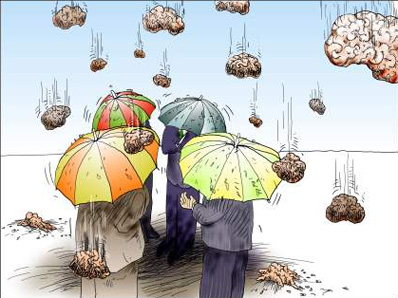The 8 Levels of a Brainstorm Session
Most people think brainstorming sessions are all about ideas -- much in the same way Wall Street bankers think life is all about money.
While ideas are certainly a big part of brainstorming, they are only a part.
People who rush into a brainstorming session starving for new ideas will miss the boat (and the train, car, and unicycle) completely unless they tune into the some other important dynamics that are also at play:
1. INVESTIGATION: If you want your brainstorming sessions to be effective, you'll need to do some investigating before hand. Get curious. Ask questions. Dig deeper. The more you find out what the real issues are, the greater your chances of framing powerful questions to brainstorm and choosing the best techniques to use.
2. IMMERSION: While good ideas can surface at any time, their chances radically increase the more that brainstorm participants are immersed. Translation? No coming and going during a session. No distractions. No interruptions. And don't forget to put a "do not disturb" sign on the door.
3. INTERACTION: Ideas come to people at all times of day and under all kinds of circumstances. But in a brainstorming session, it's the quality of interaction that makes the difference -- how people connect with each other, how they listen, and build on ideas. Your job, as facilitator, is to increase the quality of interaction.

4. INSPIRATION: Creative output is often a function of mindset. Bored, disengaged people rarely originate good ideas. Inspired people do. This is one of your main tasks, as a brainstorm facilitator -- to do everything in your power to keep participants inspired. The more you do, the less techniques you will need.
5. IDEATION: Look around. Everything you see began as an idea in someone's mind. Simply put, ideas are the seeds of innovation -- the first shape a new possibility takes. As a facilitator of the creative process, your job is to foster the conditions that amplify the odds of new ideas being conceived, developed, and articulated.
6. ILLUMINATION: Ideas are great. Ideas are cool. But they are also a dime a dozen unless they lead to an insight or aha. Until then, ideas are only two dimensional. But when the light goes on inside the minds of the people in your session, the ideas are activated and the odds radically increase of them manifesting.
7. INTEGRATION: Well-run brainstorming sessions have a way of intoxicating people. Doors open. Energy soars. Possibilities emerge. But unless participants have a chance to make sense of what they've conceived, the ideas are less likely to manifest. Opening the doors of the imagination is a good thing, but so is closure.
8. IMPLEMENTATION: Perhaps the biggest reason why most brainstorming sessions fail is what happens after -- or, shall I say, what doesn't happen after. Implementation is the name of the game. Before you let people go, clarify next steps, who's doing what (and by when), and what outside support is needed.
沒有留言:
張貼留言